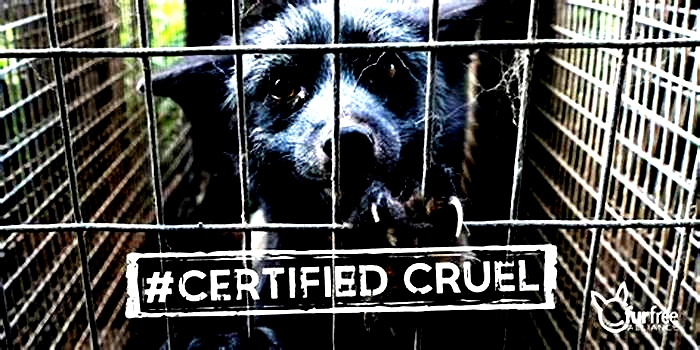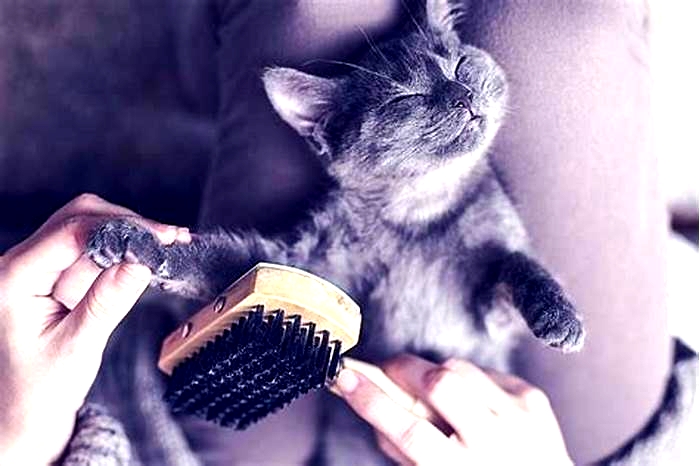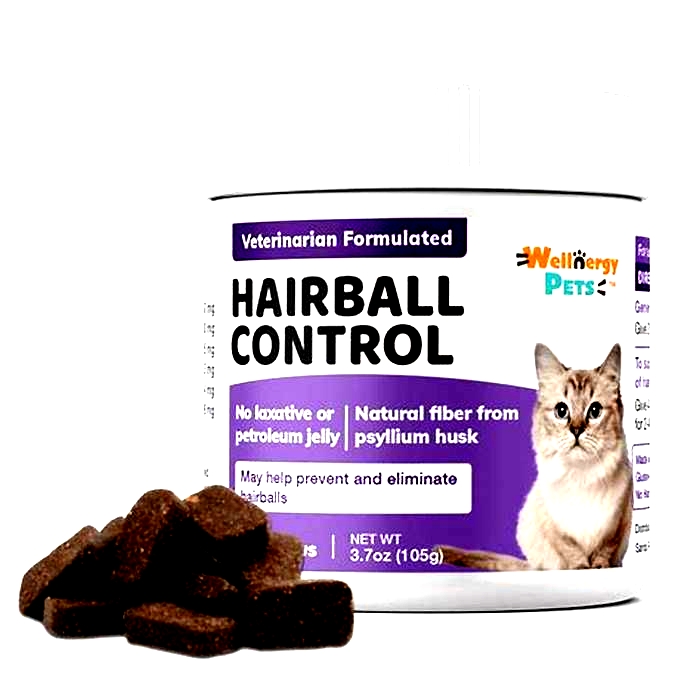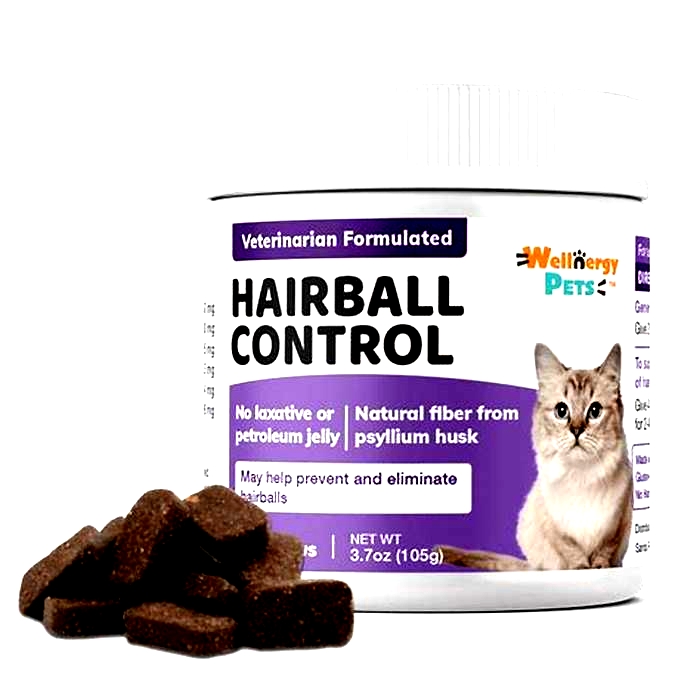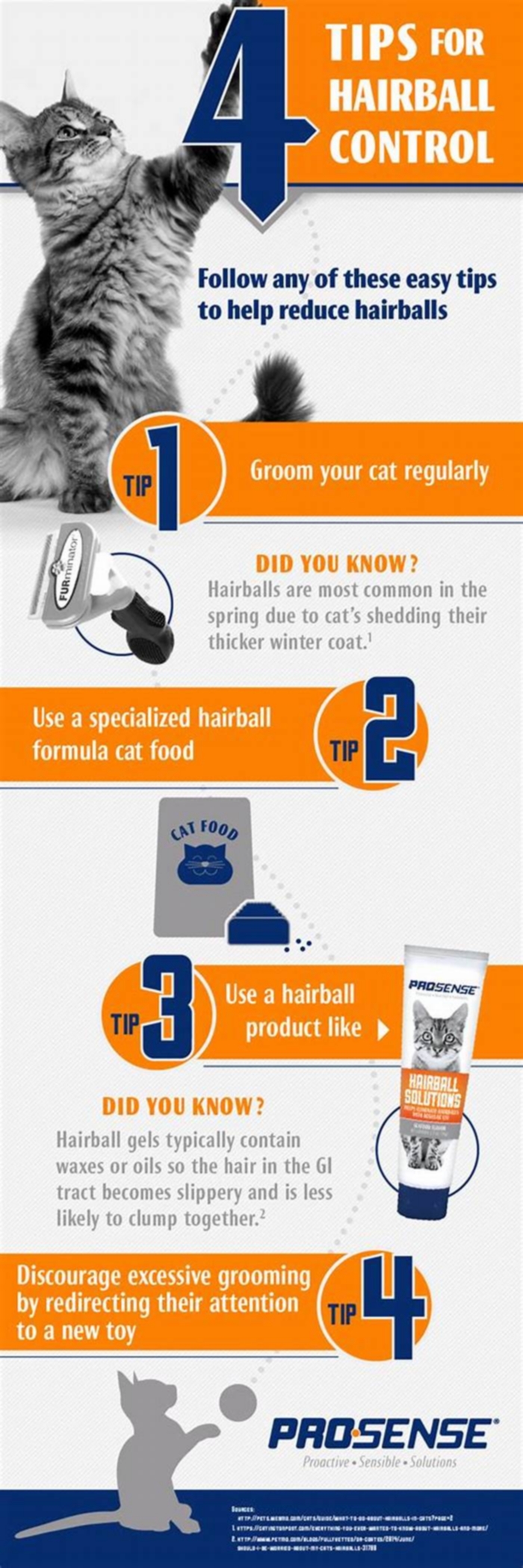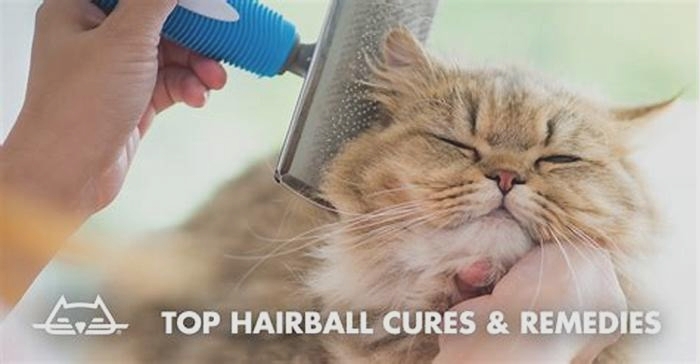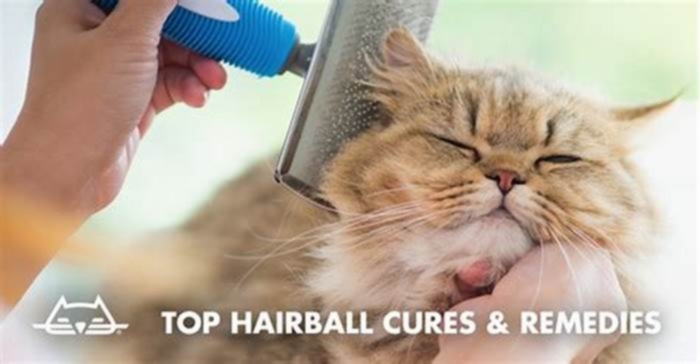Fur Free Living Discovering the Benefits of Hairball Control Treatments
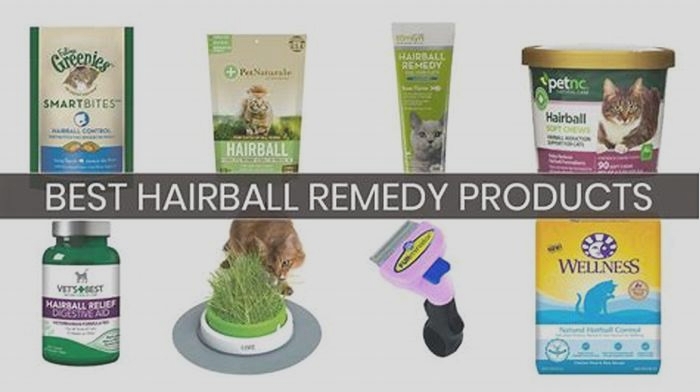
Cat Hairball Control
Your kitty is a cuddly little fur ball. And to keep him clean and cuddle-ready, his pretty coat requires both love and attention. He knows it and so do you. Like any vain kitty, he's got his cat grooming routine down to a science. He's very good at cleaning himself and, when not curled up taking a good nap, he spends many waking hours making sure his fur looks just right. But there are those times when kitty may need a little help. The constant licking and grooming can cause hairballs, which are an accumulation of hair in the digestive system, that result in kitty hurling or vomiting up a fur ball. For those moments, there are a few ways to step in and help him out a bit:Simply brushing your kitty using a cat brush like, the FURminator can help reduce the chances of fur build-up. Regular brushing diminishes shedding by up to 90%. This brush is designed to go deep beneath the topcoat and gently remove under coat and loose hair. There's also JW Pet Gripsoft Cat Comb which features a rubber sheathed handle so you can comfortably stroke and brush. Not only will this cat comb help prevent matting and formation of hairballs it's also a great way to bond with your kitty. Pair it with the Grip Soft Cat Slicker Brush for maximum effectiveness. There are also vitamin and supplements that are also useful in helping with this furry dilemma. Vets Best Hairball Relief Digestive Aid Cat Supplement is a veterinarian recommended formula packed with herbs like slippery elm bark, psyllium seed and marshmallow to provide natural hairball relief.There are fun tasty treats that can work wonders including Feline Greenies SmartBites Hairball Control Chicken Flavor Cat Treats. The best part is that you only have to give your furry friend a handful or two in his bowl and these yummy snacks begin to work their magic while he chomps away. Plus, they're not only made with real chicken protein, they also contain plant-based fiber that helps to minimize hairball formation and promote digestive health. Cat food blends that are specially made for hairball control may prove to be an ideal way to get a leg up on hairballs. Recipes like Blue Buffalo Indoor Hairball Chicken & Brown Rice Recipe Mature Dry Cat Food contain a unique blend of natural fiber sources to help control hairballs. And Iams ProActive Health Indoor Weight & Hairball Care Dry Cat Food contains natural fiber from oats to help avoid hairballs forming in the digestive tract and features fresh chicken is the first ingredient.Whether its cat food, treats or grooming products shop Chewy today for the best hairball treatments and hairball remedies around.
Related Categories: Cat Vitamins & Supplements, Vet Recommended Cat Diets, Cat Skin & Coat Care, Weight Loss Cat Food, Cat Hip and Joint Care, Cat Digestive and Urinary Health, Cat Anxiety & Stress Relief, Cat Eye Drops, Cat Ear Care, Cat Wound Care & First Aid, Cat Dewormer, Cat Test Kits, Cat Healthcare
What is the best cat hairball control treatment?
The best cat hairball control treatment will be easy to administer and effective for your cat. There are many cat hairball products to choose from, including cat hairball treats, cat food formulas for hairball control, and hairball remedies and supplements. Some people have success feeding their cats a hairball control diet, while others find they need to administer a hairball medicine like Laxatone to keep hairballs at bay. Hairball relief supplements and digestive aids can play an important role in hairball control, as well. Talk to your vet about good options for your cat and experiment to see which work best.
How do I stop my cat from getting hairballs?
Stop your cat from getting hairballs by talking to your vet about appropriate hairball care solutions. Some felines need little to no cat hairball help, while others may need a combination of interventions to avoid hairball issues. A hairball control diet combined with supplements or occasional cat hairball remedies as needed provides excellent control for many, but you may need to try a few things to find what works best for you.
The 5 Best Hairball Remedies For Cats
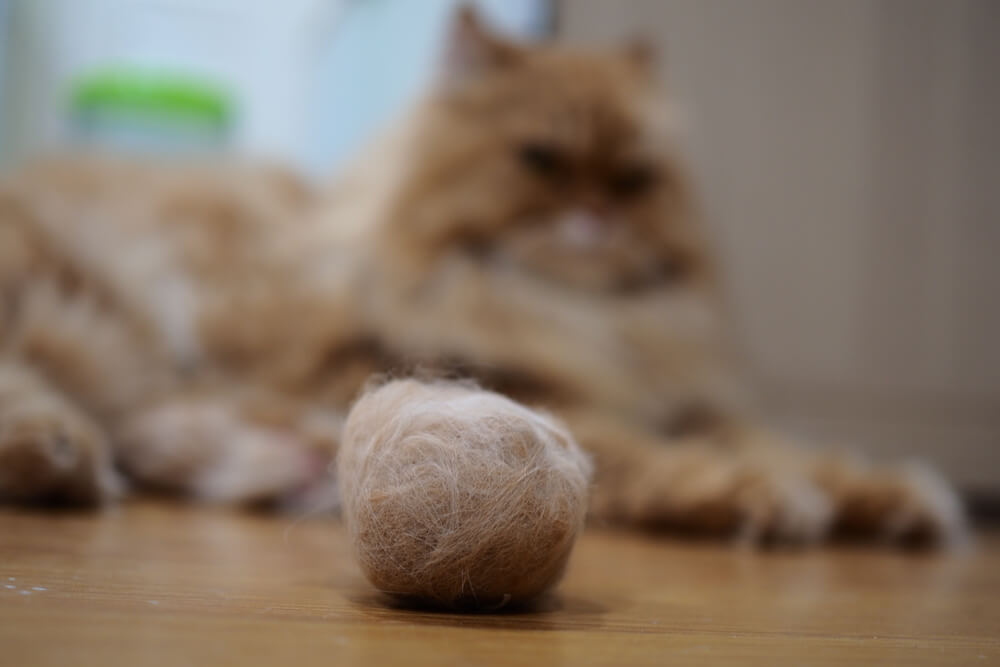
Note: Veterinary review of this article includes only the medical information in this article. The veterinarian reviewing this article does not personally endorse, recommend, or vouch for the efficacy or claims of any product mentioned in this article.
The best hairball remedies do more than help hair slide through your cats body. They treat the problem at its root by supporting overall digestive health.
Thats why we chose Cat Lax as the best hairball remedy on the market. This well known hairball gel contains a blend of ingredients that break up hairballs, prevent new ones from forming, and minimize shedding to keep hairballs at bay.
Before we learn more about Cat Lax and our other top five picks, lets talk about the types of hairball remedies and how they can help.
At a Glance: Our Top Picks for Best Hairball Remedies for Cats
Want a quick look at the products reviewed in this article? In the comparison table below, weve highlighted some of the most important features of each product. Youll find more detailed information about each product later in the article.
Overall Best
9.9
Picked by 31 people today!
- Contains a blend of lubricants
- Most cats like the gels flavor
- Affordable
Runner Up
9.8
Picked by 31 people today!
- Over 1,600 customer reviews, 4.5 star rating
- Cats seem to enjoy the tuna flavor
- Helps lubricate ingested hairs to prevent hairballs
BEST FOR BUDGET
9.6
Picked by 25 people today!
- Rich in omega-3 fatty acids
- Controls hairballs while supporting digestive health
- Most cats like the way the gel tastes
BEST HAIRBALL PREVENTION SUPPLEMENT
9.4
Picked by 21 people today!
- Most reviews are positive
- Made from a blend of well-regarded ingredients
- Appears to be safe for cats
BEST HAIRBALL CONTROL TREAT
9.3
Picked by 18 people today!
- Contains fiber to help move hair through the GI tract
- Features prebiotics and probiotics for digestive health
- Free of potentially-harmful ingredients
Types of Hairball Remedies for Cats
Hairballs form when hair gets stuck or slowed on its way through the digestive tract, allowing it to form into a clump. Once it forms into a clod, hair is unable to continue its journey to the litter box and instead it gets stuck or heads in the opposite direction.
Hairball treatments come in many different forms. You can buy hairball remedies in a tube, try homemade remedies, grow a pot of cat grass, or groom your cat to keep him from ingesting his hair at all.
Some cats with frequent hairballs may have an underlying problem like inflammatory bowel disease (IBD) that affects motility of their intestines, so diagnosing and treating this could solve their problems.
Heres a quick breakdown of the types of hairball remedies available and how they work.
Fiber
Fiber supplementation helps to bind single strands of hair to food particles, which carry the hairs on their journey towards the colon. By encouraging the hair to move quickly through the body, fiber-based hairball remedies reduce the hairs chances of fusing into a ball and coming back up.
Additionally, a small amount of dietary fiber can help keep the digestive system functioning smoothly, correcting hairball problems at their roots.
Fiber-Based Hairball Remedies
The following are sources of fiber that, when integrated into your cats diet, may help hair move smoothly through the body.
- Psyllium Husk Powder
- Ground Chia Seeds
- Guar Gum
- Powdered Cellulose
- Cat Grass
Lubrication
The second type of hairball remedies includes products that lubricate ingested hairs, preventing them from sticking together.
Petrolatum (Petroleum Jelly)
Petrolatum, also known as petroleum jelly, paraffin oil, or white petrolatum, is a highly refined derivative of petroleum. After its been fully refined, petroleum jelly appears to be safe for cats and people.
If you decide to give your cat petroleum jelly from your medicine cabinet, check the back of the package to ensure that youre giving your cat 100% plain petroleum jelly with no scents or other additives.
Hairball Gels
Most products marketed as hairball remedies are petroleum jelly-based. Others use vegetable oils or beeswax instead of petrolatum. They contain added flavors and sweeteners like malt syrup, fructose, and dextrose.
Butter and Oil
Butter and olive oil are frequently recommended for hairball control, but as digestible fats, theyre more likely to make your cat chubby than keep him from hacking up a furball.
Mineral oil had previously been recommended for hairballs, but it carries the risk of aspiration (going down into the lungs) since it doesnt trigger a cough reflex.
Other Hairball Remedies
Egg yolks have interesting properties for hairball control. They contain choline and lecithin, which work together to, respectively, encourage GI contractions and emulsify the fat that binds hairballs together.
You can provide the anti-hairball power of egg yolks by feeding your cat fresh egg yolks or by giving him an egg yolk lecithin supplement. A safe and effective dose for lecithin has not been established for cats, and most supplements formulated for people contain much more than is present in hairball products for cats.
Slippery elm bark contains soluble fiber, which may help to soothe and lubricate the digestive tract, reducing inflammation and helping the hairball move in the right direction
Dietary Changes
Though hairball-specific cat foods usually focus on fiber alone, this isnt always the right approach.
If your cat is already eating a diet with a little bit of fiber, the best dietary change is finding a food that reduces inflammation. Hairballs often indicate digestive problems and should be approached the same way youd approach any other symptom of gut inflammation, like diarrhea or vomiting.
Typically, this would mean giving your cat a high-protein food made primarily from meat and animal fat. You want as little plant matter as possible. A moisture-rich diet is ideal.
Read Our Article On The Best Cat Food For Hairball Control
Grooming
Finally, you can control hairballs by brushing your cat a couple of times a week. If your cat has a long, thick coat, you might also give him a full-body clip in the warmer months. Capturing loose hair before your cat licks it up is the most reliable means of stopping hairballs.
Read Our Guide To The Best Cat Grooming Brushes
Top 5 Best Hairball Remedies Reviewed
The following hairball remedies are popular, top-rated products that have a reputation for safety and effectiveness. Most are lubricating products, but youll also find a few that take a different approach to hairball control, addressing it as a component of digestive health.
Ultimately, you dont want to have your cat on lubricants and other hairball treatments for the rest of his life. You dont want him to have hairballs.
The above hairball remedies can help, but theyre not a complete solution to the hairball problem.
If your cat coughs up hairballs more than a few times a year, his frequent hacking is probably connected to digestive problems. In this case, he probably doesnt need to be swept out with fiber or lubricated with greasehe might need to go to the veterinarian. Extremely frequent hairballs may be a symptom of organ dysfunction, IBD, and other conditions.
If you determine that your cats hairballs are caused by a digestive issue, you may want to consider treating the hairballs the same way youd treat any chronic digestive problem.
Adjust your cats diet to reduce inflammatory ingredients and consider incorporating probiotics, prebiotics, and omega-3 fatty acids to promote digestive health
Also Read: Best Cat Food for IBD
Free of Fur Balls
What exactly are fur balls?
Cats are very clean creatures and your kitten will spend approximately five hours a day grooming themselves. In doing so, they'll pick up any loose hairs from their coat. These are difficult to spit out and will probably be swallowed. Most of the time, this will cause no problems whatsoever and the hairs will just pass through the digestive tract. Sometimes, however, the hairs can remain in the stomach and form a fur ball.
How does the fur ball get out?
Usually, once a fur ball has reached a certain size, the cat vomits it up (look out for sausage like balls of hair), although some will pass hair in their stools. Either way, it rarely causes much distress. Every now and again, a fur ball can be difficult to get rid of and the affected kitten may have repeated bouts of gagging or vomiting. If you are at all concerned, don't hesitate to call your vet.
In some very rare cases a cat may be unable to pass the fur ball naturally and surgery may be required. Thankfully, this is very unusual.

How can you help to prevent fur balls?
One of the best ways to help prevent fur balls is to groom your kitten regularly. Get into the habit of doing this when they are very young, so they get used to it.
Preventing a bad hair day
The type of grooming brush you use can be important and your vet can offer you advice on which one is best for your kitten. Many people with short-haired kittens favour a rubber brush. They're soft enough not to cause any discomfort but great at removing loose hair. If you have a long-haired kitten, you'll need to be even more diligent with grooming. A large-toothed, metal comb is probably a good choice. You'll need to step up the regularity of your brushing during Spring and Summer when your kitten will moult more heavily. This needn't be a chore, though. It can be a good way for you and your kitten to bond. A cuddle or a game is a nice way to round off a brushing session.
Can diet have a role in preventing fur balls?
There is some evidence that a high fibre, dry food such as Hill's Science Plan Adult Hairball Control can help reduce the formation of fur balls in the gut. Ask your vet for advice.
Remember - fur balls may not be nice but they're rarely anything to worry about
Seeing your kitten struggle with a fur ball can be upsetting, but it's important to remember that most cats have problems with them from time to time and there's hardly ever any reason for real concern.

